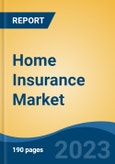Speak directly to the analyst to clarify any post sales queries you may have.
10% Free customizationThis report comes with 10% free customization, enabling you to add data that meets your specific business needs.
Market Drivers
Increasing Homeownership and Real Estate Development
The rising global homeownership rate, fueled by economic growth, urbanization, and government-backed mortgage programs, is a key driver of the home insurance market. As more individuals and families invest in residential properties, the demand for financial protection against risks such as fire, theft, and natural disasters has surged. According to the World Bank, the global homeownership rate averages around 65%, with developed countries like the U.S.and Canada exceeding 70%, while emerging markets like China and India are witnessing rapid growth due to expanding middle-class populations and housing initiatives. Additionally, large-scale real estate development projects, including smart cities and high-rise apartments, are increasing the insured property base. In regions like Asia-Pacific, real estate investments have surged, with China’s property sector alone valued at over $50 trillion. This expansion directly translates into a higher uptake of home insurance policies, as homeowners seek to safeguard their investments.
Key Market Challenges
Rising Claim Costs and Profitability Pressure
One of the most significant challenges facing the global home insurance market is the rising cost of claims, which directly impacts insurer profitability. The increasing frequency and severity of natural disasters, driven by climate change, have led to higher payouts for property damage. Additionally, inflation and supply chain disruptions have escalated construction and repair costs, further inflating claim expenses.A surge in fraudulent claims also adds financial strain, with the Coalition Against Insurance Fraud estimating that fraud costs the U.S. insurance industry over $80 billion annually. To manage these rising costs, insurers are adjusting premium rates, tightening underwriting standards, and leveraging technology such as AI and predictive analytics for more accurate risk assessments. However, balancing profitability with affordability remains a persistent challenge, as excessive premium hikes could drive policyholders away, particularly in high-risk regions where home insurance is already expensive.
Key Market Trends
Growth of Parametric Insurance for Homeowners
A significant trend reshaping the home insurance market is the increasing adoption of parametric insurance, which offers quicker payouts based on predefined triggers such as wind speeds, earthquake magnitudes, or flood levels, rather than the traditional claim-based model. Unlike conventional policies, where claim processing can take weeks or months due to damage assessment and paperwork, parametric insurance ensures immediate compensation once a predefined event occurs. This model is gaining traction in regions prone to natural disasters, such as hurricane-prone coastal areas in the United States and flood-prone regions in Asia. Insurers like Swiss Re and AXA are pioneering parametric policies to provide homeowners with faster financial relief, reducing administrative burdens and improving customer satisfaction. As climate change increases the frequency of catastrophic events, demand for parametric insurance is expected to grow, encouraging insurers to develop innovative risk-transfer solutions that provide more predictable and transparent coverage for homeowners.Key Market Players
- American International Group, Inc.
- Chubb Limited
- China People's Insurance Company (Group) Co., Ltd.
- Liberty Mutual Insurance Company
- Zurich American Insurance Company
- State Farm Mutual Automobile Insurance Company
- AXA Group
- Allstate Insurance Company
- Nationwide Mutual Insurance Company
- Admiral Group Plc
Report Scope:
In this report, the global Home Insurance Market has been segmented into the following categories, in addition to the industry trends which have also been detailed below:Home Insurance Market, By Coverage:
- Comprehensive Coverage
- Dwelling Coverage
- Content Coverage
- Others
Home Insurance Market, By End User:
- Landlords
- Tenants
Home Insurance Market, By Provider:
- Insurance Companies
- Insurance Agents/Brokers
- Insurtech Companies
- Others
Home Insurance Market, By Region:
- North America
- United States
- Canada
- Mexico
- Europe
- France
- Germany
- Spain
- Italy
- United Kingdom
- Asia-Pacific
- China
- Japan
- India
- Vietnam
- South Korea
- Middle East & Africa
- South Africa
- Saudi Arabia
- UAE
- Turkey
- South America
- Brazil
- Argentina
- Colombia
Competitive Landscape
Company Profiles: Detailed analysis of the major companies present in the global Home Insurance Market.Available Customizations:
With the given market data, the publisher offers customizations according to a company's specific needs. The following customization options are available for the report.Company Information
- Detailed analysis and profiling of additional market players (up to five).
This product will be delivered within 1-3 business days.
Table of Contents
Companies Mentioned
- American International Group, Inc.
- Chubb Limited
- China People's Insurance Company (Group) Co., Ltd.
- Liberty Mutual Insurance Company
- Zurich American Insurance Company
- State Farm Mutual Automobile Insurance Company
- AXA Group
- Allstate Insurance Company
- Nationwide Mutual Insurance Company
- Admiral Group Plc
Table Information
| Report Attribute | Details |
|---|---|
| No. of Pages | 181 |
| Published | March 2025 |
| Forecast Period | 2024 - 2030 |
| Estimated Market Value ( USD | $ 240.15 Billion |
| Forecasted Market Value ( USD | $ 390.68 Billion |
| Compound Annual Growth Rate | 8.4% |
| Regions Covered | Global |
| No. of Companies Mentioned | 10 |









